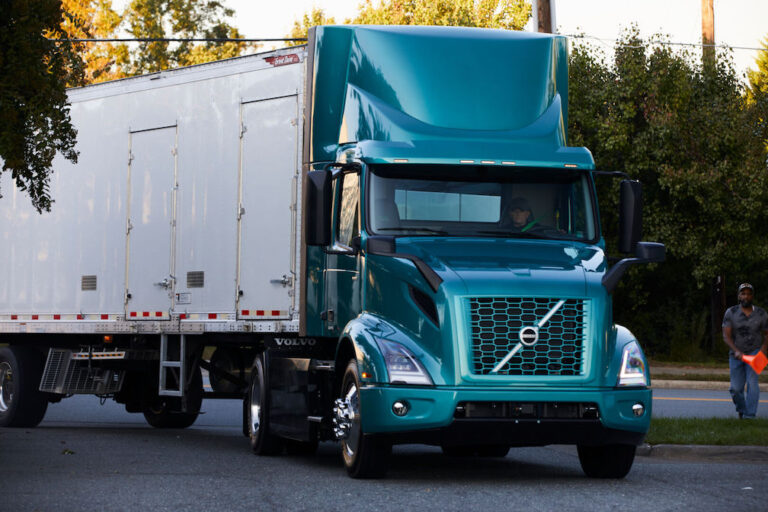Volvo Trucks North America announced that it has successfully delivered 70 Volvo VNR Electric trucks as part of a $21.5M funding initiative supported by the U.S. Environmental Protection Agency (EPA) and the South Coast Air Quality Management District (South Coast AQMD).
According to its media release, the project, named “SWITCH-ON,” has deployed these zero-tailpipe emission trucks to several fleets across Southern California for regional freight distribution and drayage. Initially announced in 2020, SWITCH-ON is now one of the nation’s largest commercial deployments of Class 8 battery-electric trucks. To date, Volvo Trucks has delivered more than 570 Volvo VNR Electric trucks across 31 U.S. states and Canadian provinces.
The SWITCH-ON project was backed by up to $19.5 million from the EPA’s Targeted Air Shed Grant Program, supplemented by $2 million from South Coast AQMD for charging infrastructure, aiming to improve air quality in the region.
The first 15 trucks delivered were the first generation of commercially available Volvo VNR Electric trucks, while the remaining 55 are next-generation models featuring extended range and faster charging capabilities.
Fleets participating in the SWITCH-ON program include:
- CEVA
- IMC Logistics
- McLane
- NFI
- Performance Team, a Maersk Company
- Pier Enterprises Group Inc./DBA DC Logistics
- Western Regional Delivery Service/South Coast Transportation & Distribution
Volvo says these trucks will collect data on performance in drayage and freight applications through 2025, providing at least a full year of operational insights for all the trucks.
“There are challenges on the road to electromobility adoption, but through close collaboration with public entities, utilities, manufacturers and other key industry partners, we can overcome these barriers and achieve our zero-emission goals,” said Peter Voorhoeve, president of Volvo Trucks North America. “We’re pleased to say that with successful collaboration, we’ve together been able to find solutions that are critical for these fleets and have been able to deploy the 70 Volvo VNR Electric trucks. By sharing our experiences and overcoming these challenges, we are paving the way for a broader industry adoption, just as we did with the Volvo LIGHTS project and our participation in the JETSI project.”
Beyond the SWITCH-ON program, Volvo Trucks has also introduced other innovative solutions to accelerate battery-electric vehicle (BEV) adoption including working with Volvo Financial Services to launch Volvo on Demand that follows the Truck-as-a-Service (TaaS) business model. With Volvo on Demand, customers can minimize the upfront investment associated with transitioning to battery-electric trucks and leverage the established electromobility ecosystem tailored for Volvo VNR Electric trucks in North America.
“Infrastructure development remains a challenge for fleets, even with public funding,” said Wayne Nastri, South Coast AQMD’s Executive Officer. “Through SWITCH-ON, fleets have explored innovative solutions to utilize battery-electric trucks despite infrastructure delays. We are committed to supporting zero-emission technology and improving air quality in our communities while enabling businesses to thrive.”
The EPA Targeted Air Shed Grant Program focuses on regions with the highest ozone and particulate matter (PM) pollution, including California’s South Coast Air Basin. South Coast AQMD is the agency responsible for attaining state and federal air quality standards for this region, which includes large areas of Los Angeles, Orange, San Bernardino, and Riverside counties, including the Coachella Valley.
“Getting to zero emissions in transportation and addressing the air pollution harming our communities, especially those that bear the brunt of freight movement emissions, requires us to adopt clean technologies on a large scale,” said EPA Pacific Southwest Regional Administrator Martha Guzman. “We at EPA are proud to support this public-private partnership, funding the deployment of these 70 electric trucks.”
The 70 Volvo VNR Electric trucks deployed through this grant are expected to provide lifetime emission reduction benefits exceeding 152.63 tons of NOx, 1.317 tons of PM2.5, and 53,160 tons of CO2. South Coast AQMD will lead the data analysis efforts to evaluate the full breadth of emission reduction opportunities presented by battery-electric trucks.
All 70 of the Volvo VNR Electric trucks will be supported by TEC Equipment – Fontana, which played a key role in helping Volvo Trucks develop the Certified Electric Vehicle Dealership certification as part of the Volvo LIGHTS project. TEC Equipment – Fontana will serve as the primary resource for participating fleets, providing local support for driver training, maintenance, and repairs to maximize fleet uptime and performance.
Bruce Guthrie is an award-winning journalist who has lived in three states including Arkansas, Missouri and Georgia. During his nearly 20-year career, Bruce has served as managing editor and sports editor for numerous publications. He and his wife, Dana, who is also a journalist, are based in Carrollton, Georgia.








